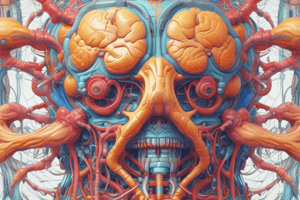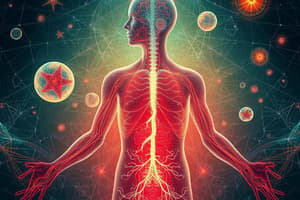Podcast
Questions and Answers
What is the main purpose of homeostasis in organisms?
What is the main purpose of homeostasis in organisms?
- To enhance the intensity of internal conditions
- To maintain a stable internal environment (correct)
- To eliminate all external stimuli
- To prevent any changes in the environment
Which of the following best describes a stimulus in the context of homeostasis?
Which of the following best describes a stimulus in the context of homeostasis?
- The result of an organism's response to external factors
- An internal condition that remains constant
- A mechanism that stabilizes a system's output
- A change in the environment that triggers a response (correct)
In a positive feedback mechanism, what typically happens to the output of a system?
In a positive feedback mechanism, what typically happens to the output of a system?
- It causes immediate shutdown of the system
- It enhances the output of the system's response (correct)
- It diminishes over time, stabilizing the system
- It has no effect on the system's response
What occurs in a negative feedback loop?
What occurs in a negative feedback loop?
Which of the following is an example of a positive feedback mechanism?
Which of the following is an example of a positive feedback mechanism?
Flashcards
Homeostasis
Homeostasis
Maintaining stable internal conditions despite environmental changes.
Positive Feedback Loop
Positive Feedback Loop
A loop where the output increases the response.
Negative Feedback Loop
Negative Feedback Loop
A loop where the output decreases the response.
Stimulus
Stimulus
Signup and view all the flashcards
Dynamic Equilibrium
Dynamic Equilibrium
Signup and view all the flashcards
Study Notes
Homeostasis and Cell Transport
- Organisms maintain internal stability through homeostasis
- Organisms respond to stimuli (changes in environment)
- Responses help maintain homeostasis
- Mechanisms evolve to help maintain homeostasis as organisms respond to stimuli
- Mechanisms use the input of a system to signal a change
Positive Feedback Mechanisms
- In a positive feedback loop, the system output intensifies the response
- Examples:
- Childbirth: Hormones cause contractions, increasing pressure, releasing more hormones, and further intensifying contractions
- Fruit ripening: Ripening fruit releases ethylene gas, causing neighbor fruit to ripen, releasing more ethylene, etc.
Negative Feedback Mechanisms
- In a negative feedback loop, the system output causes a counter-response to return to a set point
- Examples:
- Human body thermoregulation (temp)
- Osmoregulation (fluid balance)
- Blood sugar regulation
Studying That Suits You
Use AI to generate personalized quizzes and flashcards to suit your learning preferences.




